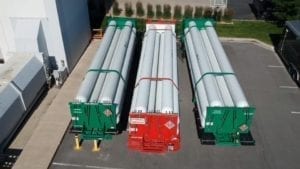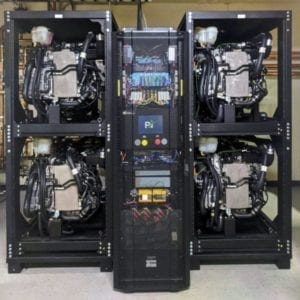Hydrogen power is gaining ground quickly in many applications, and recent breakthroughs have proven its efficacy in datacenter use. Power Innovations (American Fork, Utah) and Microsoft recently announced a breakthrough in renewable energy: hydrogen fuel cells were successfully used to power a row of datacenter servers for 48 consecutive hours. A specialist in green hydrogen, Power Innovations has also launched a project focused on generation of hydrogen using waste gases from petroleum drilling sites.
A full datacenter server load –200kW of hyperscale computers and computer simulators– was run on hydrogen-powered fuel cells for 48 continuous hours, longer than ever before. In September of 2019, the same test was performed for 24 continuous hours, which at that time was a first in the industry.

Electrolyzers were used to generate hydrogen power for a datacenter server demonstration project (Source: Microsoft)
By running four automotive fuel cells in parallel to generate 10,500+ kWh of pollution-free electricity in 48 hours, Power Innovation’s Hydrogen Fuel Cell Innovation Lab set a new record for hydrogen-generated computer backup power. This successful test demonstrates that hydrogen power is a viable, long duration, pollution-free solution to data center primary and backup power needs.
During this test, 10,560 kWh of electricity was produced; 51 kg of hydrogen was consumed; and over 7,000 + L of pure water was produced, says Power Innovations.
According to Power Innovations, in the United States alone, data centers require 90 billion kw-hours of electricity every year. To put that into perspective, that’s as much electricity as is produced in 34 giant 500-megawatt coal-powered plants. The numbers are even more staggering when considering the global footprint: roughly 416 terawatts of electricity are required to power data centers around the world. As big as these numbers are, they’re only getting bigger. Data center capacity doubles every three years and electricity consumption from data centers doubles every four.
According to Mark Monroe, a principle infrastructure engineer on Microsoft’s team for datacenter advanced development, an Azure datacenter outfitted with fuel cells, a hydrogen storage tank and an electrolyzer that converts water molecules into hydrogen and oxygen could be integrated with the electric power grid to provide load balancing services.

Power Innovations built a 250-kilowatt fuel cell system to help Microsoft explore the potential of using hydrogen fuel cells for backup power generation at datacenters. In a proof of concept, the system powered a row of datacenter servers for 48 consecutive hours. Credit: Power Innovations.
For example, the electrolyzer could be turned on during periods of excess wind or solar energy production to store the renewable energy as hydrogen. Then, during periods of high demand, Microsoft could start up the hydrogen fuel cells to generate electricity for the grid.
“All of that infrastructure represents an opportunity for Microsoft to play a role in what will surely be a more dynamic kind of overall energy optimization framework that the world will be deploying over the coming years,” said Lucas Joppa, Microsoft’s chief environmental officer.
To further explore how Microsoft can leverage its investment in hydrogen fuel cells and related infrastructure, the company today named Joppa as its representative on the Hydrogen Council, a global initiative of leading energy, transport and industry companies to spur the hydrogen economy.
Scientists have already proved that hydrogen fuel cells can be used to generate greenhouse gas-free energy from the most abundant element in the universe, Joppa noted.
“We know how to do it,” he said. “The council exists because we don’t necessarily know how to scale the generation of hydrogen, transportation of hydrogen, supply of hydrogen and then consumption of it in the various ways that we would like to. There’s still tons of work that needs to be done.”